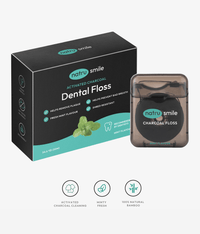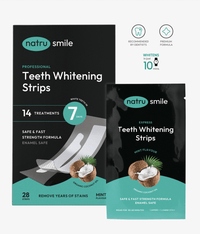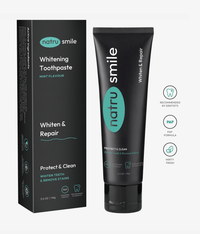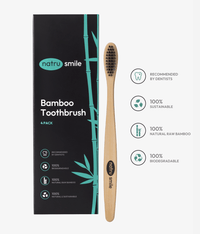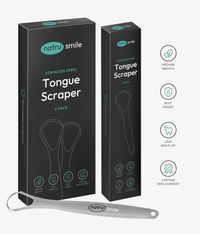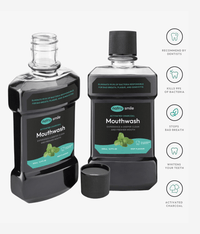
All products are certified by dental expert Dr. Greg Grillo
Many of us have been there (or are there!) - munching away on our favorite snack or meal, and suddenly we feel something strange in our mouth. Uh-oh, our filling has fallen out!
It's a frustrating and uncomfortable situation, but don't worry, you're not alone. In fact, with 1 of 4 adults aged 20 to 64 have had a cavity at some point in their lives, many are bound to have experienced it. But what should you do if it happens to you? Well, that's where we come in.
In this article, we'll explore everything you need to know about what to do when your filling falls out. We'll cover why fillings fall out, how to prevent it from happening, and most importantly, the steps you need to take to protect your tooth and ease any discomfort. So, sit tight and read on to become a filling-falling-out-pro in no time.
What To Do If Your Filling Falls Out: Step-By-Step Guide
It's normal to feel a bit panicked when your dental filling falls out, but try and stay calm. Take some deep breaths, and keep in mind that this isn't an emergency.
We’re here to provide you with some relief and step-by-step instructions on what you can do in this situation. Read on to find out more!
Schedule An Appointment With Your Dentist
When your dental filling falls out, it might be tempting to ignore it and hope the problem goes away. After all, nobody likes going to the dentist, right? However, scheduling an appointment with your dentist should be your first step in addressing the issue.
A missing filling can lead to further tooth decay or damage if left untreated. This can result in more extensive and expensive dental procedures down the line, so it's best to tackle the issue as soon as possible.
Scheduling an appointment with your dentist is a crucial first step when your filling falls out. It can help prevent extra issues, alleviate pain, and provide guidance for maintaining your oral health. So don't hesitate – pick up the phone and schedule that appointment!
Remove And Keep The Filling
This might seem like an odd thing to do, but if you find your filling on the floor or a small piece of the filling fell out, it's important to keep it.
Why is keeping the filling important? For starters, it can provide valuable information to your dentist about the condition of your tooth and the quality of the filling. They can examine the filling for signs of wear and tear, decay, or other issues that may have contributed to its failure. This information can be used to help prevent future fillings from falling out.
Keeping the filling can also potentially save you time and money. If the filling is still in good condition, your dentist may be able to reuse it, saving you the cost of a new filling. It’s especially helpful if you don't have dental insurance or are on a tight budget.
If it’s still in your tooth, don’t fret! Removing the filling itself is a relatively simple process. Using a pair of tweezers or a dental pick, gently wiggle and pull the filling until it comes loose. Be sure to handle the filling carefully, as it may be sharp and could cause injury.
Once the filling is removed, place it in a small container or baggie to bring to your dental appointment. Your dentist will examine the filling and determine if it can be reused or if a new filling is necessary.
Gently Brush Your Teeth
When your filling falls out, brushing your teeth might not seem like the obvious thing to do, but it's actually a big step to prevent any further damage to your tooth. An absent filling can leave a gap or hole in your tooth that can trap food and bacteria. And if you don't take care of it, this can lead to decay or even infection.
To avoid any complications, gently brush your teeth. Grab a soft-bristled toothbrush and brush in gentle circular motions, being careful not to brush too hard or put too much pressure on your tooth. This will help remove any debris or bacteria that might be hanging out in that gap.
Gargle With Salt Water
At this point, you might still be feeling sore. One simple step you can take to help alleviate discomfort and prevent infection is gargling with salt water.
When a filling falls out, it leaves behind an exposed and vulnerable area in your tooth. This can be a breeding ground for bacteria, which can lead to infection.
Gargling with salt water helps to disinfect the area and soothe any irritation or pain.
But why salt water specifically? Salt has natural antibacterial properties, making it an effective and inexpensive way to clean your mouth. It can also help to bring down the inflammation and promote healing.
To make your own saltwater solution, simply dissolve a teaspoon of salt in a cup of warm water. Tilt your head back and gargle the solution in the affected area for about 30 seconds before spitting it out. Repeat this process several times a day to keep the area clean and promote healing.
Use Dental Wax To Fill The Void
Did you know that dental wax can be a lifesaver in these situations?
Dental wax can help to fill the void and provide some much-needed relief. It's a soft, pliable material that can be molded to fit the shape of your tooth and the void left by the missing filling.
Using dental wax is a simple process. First, clean the affected tooth and surrounding area. Next, take a small piece of dental wax and roll it into a ball between your fingers. Then, gently press the wax into the void left by the missing filling, using your fingers to shape it as needed. The wax will stick to your tooth and create a temporary barrier to protect the exposed area.
Dental wax can also be helpful if the missing filling is causing discomfort when you bite down. Simply apply a small piece of wax to the top of the affected tooth and bite down gently. The wax will help to cushion the tooth and reduce any pain or sensitivity.
Take A Pain Reliever
If your tooth is still feeling pretty sensitive and uncomfortable, what can you do to ease the pain until your dentist appointment? Reach for a pain reliever.
Ibuprofen, acetaminophen, or other over-the-counter pain relievers can work to reduce any pain or discomfort you may be feeling. They function by blocking the production of pain-causing chemicals in your body, so you can get some relief while you wait for your appointment.
When taking pain relievers, be sure to follow the dosage instructions carefully and don't exceed the recommended amount. And if you have any health conditions or take any medications, be sure to check with your doctor or pharmacist before taking any pain relievers.
Don’t forget this is just a temporary solution. Taking pain relievers can mask the pain, but it won't fix the underlying problem - so make that dental appointment as soon as you can!
Maintain A Dental Hygiene Routine
Gently brushing your teeth after losing a filling is recommended, but keeping a consistent oral hygiene routine is even more crucial.
Make sure you brush twice a day with a fluoride toothpaste, floss daily, and use mouthwash. Pay special attention to the area where the filling fell out, and be gentle when brushing around it. As mentioned, you’ll want to use a soft-bristled toothbrush or a toothbrush specifically designed for sensitive teeth.
If you're experiencing sensitivity or discomfort, you can also try using a toothpaste formulated for sensitive teeth. These toothpastes contain ingredients like potassium nitrate or strontium chloride that can help to desensitize the tooth and reduce pain.
By maintaining a good dental hygiene routine, you can help take care of your tooth and reduce the risk of losing more fillings in the future. So don't forget to brush, floss, and rinse - your teeth (and your fillings) will thank you.
Avoid Chewing On the Affected Tooth
When you chew on the affected tooth, it puts pressure on the area and can cause more pain or sensitivity. Additionally, if there's a void where the filling used to be, food particles can get stuck there and cause more irritation or infection.
So if you've lost a filling, try to completely avoid chewing on that side of your mouth. Instead, chew on the opposite side or stick to soft foods that won't put too much pressure on the affected tooth.
Remember, the goal is to avoid causing further damage or discomfort until you can have the filling replaced. So take it easy on that tooth and give it some extra TLC until it can be fixed up good as new!
What Caused My Filling To Fall Out?
Most people don’t expect their dental fillings to fall out, so it might be a shock when it happens. There are several reasons why it might’ve happened, including:
- Wear and tear: Over time, fillings can wear down or become loose due to everyday use and pressure.
- Decay: If tooth decay develops underneath the filling, it can weaken the bond between the filling and the tooth.
- Grinding or clenching: People who grind or clench their teeth can put extra pressure on fillings.
- Trauma: If you experience trauma to your mouth or teeth, it can cause fillings to become dislodged.
- Poor placement: If a filling isn’t placed correctly or the tooth isn’t properly prepared before the filling is done, it can fall out.
What To Expect At Your Dental Appointment
During your appointment, your dentist will examine the tooth and determine the best course of action. They may need to replace the filling or even perform additional dental work, depending on the extent of the damage.
Your dentist will make sure you're comfortable throughout the process and will take steps to ensure your recovery is as quick and painless as possible.
Furthermore, your dentist can provide valuable insight into preventing future fillings from falling out. They can evaluate the quality of the filling and suggest adjustments or changes in your oral care routine to keep your teeth healthy and strong.
What To Do If Your Dentist Can’t See You
Perhaps your dentist is fully booked for weeks, or they’ve gone on a long holiday. If your dentist can't see you right away, here are a few tips:
- Call around to other dentists: Try calling other dental offices in your area to see if they can fit you in for an appointment.
- Consider a walk-in clinic: Some dental offices offer walk-in services or emergency appointments for situations like a lost filling. Check with clinics in your area to see if this is an option.
- Use temporary filling materials: You can find temporary filling materials at most drug stores or pharmacies. These materials can be used to fill the void left by the lost filling until you can see a dentist.
- Avoid hard or sticky foods: Until you can have your filling replaced, avoid hard or sticky foods that could damage your tooth or cause pain.
- Practice good dental hygiene: Even if you can't see a dentist right away, continue practicing good dental hygiene - brush, floss, and mouthwash!
Interested in learning even more about lost or cracked dental fillings? Read on for answers to some frequently asked questions.
How Can You Prevent A Filling From Coming Loose?
A huge factor in keeping your fillings in tip-top shape is to practice good oral hygiene by brushing and flossing regularly. You’ll also want to avoid chewing on hard substances like ice or hard candy, and avoid using your teeth to open packages or bottles. If you clench or grind your teeth, ask your dentist about a mouthguard or other options to protect your teeth.
Something you shouldn’t skip out on is attending regular dental checkups to address any issues with your fillings before they become a bigger problem. Be mindful of any changes in your teeth or fillings, such as sensitivity or pain, and seek prompt dental care if you notice any issues.
Can A Cracked Filling Be Replaced?
Yes, cracked fillings can be replaced by a dentist. During the replacement process, the dentist will first remove the old filling and any decayed or damaged parts of the tooth. They will then prepare the tooth for the new filling material, which may be a composite resin, amalgam, or other material.
After the new filling is placed, the dentist will shape and polish it to fit your bite and feel comfortable in your mouth. All fillings do have a lifespan and may need to be replaced periodically over time to maintain their effectiveness.
Do You Need To Pay For A Replacement Filling?
The cost of a replacement filling will depend on a few factors, such as your dental insurance coverage, the type of filling material used, and the location and experience of your dentist.
Occasionally, dental insurance may cover the cost of a replacement filling or at least a portion of it. It’s likely beneficial to check with your insurance provider to see what kind of coverage you have.
How Much Does It Cost To Replace A Filling?
If you're not covered by dental insurance, getting a filling can be a bit of a mystery in terms of cost. It depends on different factors, such as where your dentist is located, how big the cavity is, and what type of filling material they use.
To give you a general idea, here are some price ranges for the different filling materials:
- Silver Amalgam Fillings: Silver amalgam fillings are made of a combination of metals, including silver, copper, and mercury. They are generally the least expensive type of filling material, with a cost range of $50 to $200 per tooth.
- Composite Fillings: Composite fillings, which are made of a tooth-colored resin, can range from $175 to $250 per tooth.
- Glass Ionomer Fillings: Glass ionomer fillings are a type of dental cement that can be used for small to medium-sized cavities. With a cost range of $95 to $250 per tooth, they are typically less expensive than composite fillings.
- Gold Fillings: Gold fillings are the most expensive type of filling material, with a cost range of $300 to $1,000 per tooth. While gold fillings are highly durable and long-lasting, they are not as widely used due to their high cost and their appearance.
Dental work can be pricey, but don't let that stop you from getting the care you need. If you're worried about the cost of a filling, your dentist might have some suggestions for a more affordable filling material or be able to work out a payment plan with you to make it easier on your wallet.
Is A Filling Falling Out An Emergency?
A filling falling out is not always a dental emergency, but we recommend addressing it as soon as possible. While a missing filling may not cause immediate pain, it leaves the tooth vulnerable to decay and sensitivity. In general, it's a good idea to contact your dentist and schedule an appointment as soon as possible to assess the situation and determine the best course of action.
How Long Can You Wait If A Filling Falls Out?
The short answer is: it's best to act fast. Try to schedule an appointment with your dentist as soon as possible - within a few days if you can. If life gets in the way and you're not able to see a dentist right away, take some steps to protect your tooth until you can get in. The longer you wait, the higher the chance of an infection, so don't delay too long!
Should I Be Worried If My Filling Falls Out?
When it comes to any tooth-related issue, it's understandable to feel concerned. Luckily, if you’re proactive and get the missing filling treated ASAP, there shouldn’t be a big cause for concern.
Can I Glue A Filling Back In?
Under no circumstances should you glue a filling back in. While it may be tempting to fix the problem yourself, attempting to glue a filling back in can do more harm than good.
Dental fillings are designed to be placed by a trained dentist, using specialized materials and techniques to ensure a secure and long-lasting bond with the tooth. As well, using adhesives or other substances not intended for dental use can be dangerous and may cause harm to the tooth or surrounding tissues.
Trying to fix the problem yourself is not recommended and may lead to more extensive dental work in the future.
What Do I Do If My Filling Falls Out On A Weekend?
If a filling falls out on a weekend or outside of regular dental office hours, you’ll have to protect the tooth until you can see your dentist. As mentioned above, avoid chewing on the affected tooth, gargle with salt water, and gently clean and brush the area. Right when the dentist’s office is open, schedule an appointment as soon as possible.
Can Chewing Gum Pull Out Fillings?
Chewing gum itself isn’t likely to pull out fillings. Dental fillings are securely bonded to the tooth surface, and it would take a significant force to dislodge them. However, there are some situations in which chewing gum could potentially cause problems with fillings.
For example, if a filling is already loose or damaged, chewing gum could put additional pressure on the filling and cause it to come out. Or, if you chew gum aggressively or frequently, it could potentially wear down or damage the filling over time.
What Happens If I Swallow A Filling?
If you accidentally swallow a filling, don't panic - it's unlikely to cause any harm.
Dental fillings are typically made of non-toxic materials, such as composite resin, and are small enough to pass through your digestive system without causing any blockages.
In rare cases where you might experience discomfort or unusual symptoms after swallowing a filling, such as stomach pain or difficulty breathing - seek medical attention right away.


